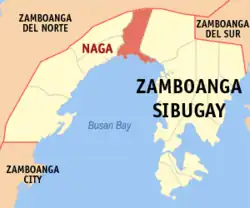Naga, Zamboanga Sibugay
Naga, officially the Municipality of Naga (Cebuano: Lungsod sa Naga; Chavacano: Municipalidad de Naga; Tagalog: Bayan ng Naga), is a 3rd class municipality in the province of Zamboanga Sibugay, Philippines. According to the 2020 census, it has a population of 41,743 people.[3]
Naga | |
|---|---|
| Municipality of Naga | |
 Flag  Seal | |
 Map of Zamboanga Sibugay with Naga highlighted | |
OpenStreetMap | |
.svg.png.webp) Naga Location within the Philippines | |
| Coordinates: 7°47′52″N 122°41′40″E | |
| Country | Philippines |
| Region | Zamboanga Peninsula |
| Province | Zamboanga Sibugay |
| District | 2nd district |
| Barangays | 23 (see Barangays) |
| Government | |
| • Type | Sangguniang Bayan |
| • Mayor | Rino O. delos Reyes |
| • Vice Mayor | Romeo P. Pantag |
| • Representative | Antonieta R. Eudela |
| • Municipal Council | Members |
| • Electorate | 27,664 voters (2022) |
| Area | |
| • Total | 246.30 km2 (95.10 sq mi) |
| Elevation | 27 m (89 ft) |
| Highest elevation | 266 m (873 ft) |
| Lowest elevation | −2 m (−7 ft) |
| Population (2020 census)[3] | |
| • Total | 41,743 |
| • Density | 170/km2 (440/sq mi) |
| • Households | 9,235 |
| Economy | |
| • Income class | 3rd municipal income class |
| • Poverty incidence | 32.79 |
| • Revenue | ₱ 162.9 million (2020) |
| • Assets | ₱ 403.9 million (2020) |
| • Expenditure | ₱ 158.2 million (2020) |
| • Liabilities | ₱ 106.9 million (2020) |
| Service provider | |
| • Electricity | Zamboanga del Sur 2 Electric Cooperative (ZAMSURECO 2) |
| Time zone | UTC+8 (PST) |
| ZIP code | 7004 |
| PSGC | |
| IDD : area code | +63 (0)62 |
| Native languages | Subanon Cebuano Chavacano Tagalog |
| Website | www |
Geography
Barangays
Naga is politically subdivided into 23 barangays. Each barangay consists of puroks while some have sitios.
- Aguinaldo
- Baga
- Baluno
- Bangkaw-bangkaw
- Cabong
- Crossing Santa Clara
- Gubawang
- Guintoloan
- Kaliantana
- La Paz
- Lower Sulitan
- Mamagon
- Marsolo
- Poblacion
- San Isidro
- Sandayong
- Santa Clara
- Sulo
- Tambanan
- Taytay Manubo
- Tilubog
- Tipan
- Upper Sulitan
Climate
| Climate data for Naga, Zamboanga Sibugay | |||||||||||||
|---|---|---|---|---|---|---|---|---|---|---|---|---|---|
| Month | Jan | Feb | Mar | Apr | May | Jun | Jul | Aug | Sep | Oct | Nov | Dec | Year |
| Average high °C (°F) | 31 (88) |
31 (88) |
31 (88) |
31 (88) |
30 (86) |
29 (84) |
29 (84) |
29 (84) |
29 (84) |
29 (84) |
30 (86) |
30 (86) |
30 (86) |
| Average low °C (°F) | 23 (73) |
23 (73) |
23 (73) |
24 (75) |
25 (77) |
25 (77) |
24 (75) |
24 (75) |
24 (75) |
24 (75) |
24 (75) |
23 (73) |
24 (75) |
| Average precipitation mm (inches) | 61 (2.4) |
55 (2.2) |
75 (3.0) |
81 (3.2) |
145 (5.7) |
189 (7.4) |
189 (7.4) |
197 (7.8) |
162 (6.4) |
181 (7.1) |
115 (4.5) |
70 (2.8) |
1,520 (59.9) |
| Average rainy days | 16.4 | 15.7 | 19.1 | 21.5 | 26.9 | 27.1 | 26.4 | 25.0 | 24.2 | 26.8 | 23.5 | 18.7 | 271.3 |
| Source: Meteoblue[5] | |||||||||||||
Demographics
|
| ||||||||||||||||||||||||||||||||||||
| Source: Philippine Statistics Authority[6][7][8][9] | |||||||||||||||||||||||||||||||||||||
Economy
References
- Municipality of Naga | (DILG)
- "2015 Census of Population, Report No. 3 – Population, Land Area, and Population Density" (PDF). Philippine Statistics Authority. Quezon City, Philippines. August 2016. ISSN 0117-1453. Archived (PDF) from the original on May 25, 2021. Retrieved July 16, 2021.
- Census of Population (2020). "Region IX (Zamboanga Peninsula)". Total Population by Province, City, Municipality and Barangay. Philippine Statistics Authority. Retrieved 8 July 2021.
- "PSA Releases the 2018 Municipal and City Level Poverty Estimates". Philippine Statistics Authority. 15 December 2021. Retrieved 22 January 2022.
- "Naga: Average Temperatures and Rainfall". Meteoblue. Retrieved 1 May 2020.
- Census of Population (2015). "Region IX (Zamboanga Peninsula)". Total Population by Province, City, Municipality and Barangay. Philippine Statistics Authority. Retrieved 20 June 2016.
- Census of Population and Housing (2010). "Region IX (Zamboanga Peninsula)" (PDF). Total Population by Province, City, Municipality and Barangay. National Statistics Office. Retrieved 29 June 2016.
- Censuses of Population (1903–2007). "Region IX (Zamboanga Peninsula)". Table 1. Population Enumerated in Various Censuses by Province/Highly Urbanized City: 1903 to 2007. National Statistics Office.
- "Province of Zamboanga Sibugay". Municipality Population Data. Local Water Utilities Administration Research Division. Retrieved 17 December 2016.
- "Poverty incidence (PI):". Philippine Statistics Authority. Retrieved December 28, 2020.
- "Estimation of Local Poverty in the Philippines" (PDF). Philippine Statistics Authority. 29 November 2005.
- "2003 City and Municipal Level Poverty Estimates" (PDF). Philippine Statistics Authority. 23 March 2009.
- "City and Municipal Level Poverty Estimates; 2006 and 2009" (PDF). Philippine Statistics Authority. 3 August 2012.
- "2012 Municipal and City Level Poverty Estimates" (PDF). Philippine Statistics Authority. 31 May 2016.
- "Municipal and City Level Small Area Poverty Estimates; 2009, 2012 and 2015". Philippine Statistics Authority. 10 July 2019.
- "PSA Releases the 2018 Municipal and City Level Poverty Estimates". Philippine Statistics Authority. 15 December 2021. Retrieved 22 January 2022.
This article is issued from Wikipedia. The text is licensed under Creative Commons - Attribution - Sharealike. Additional terms may apply for the media files.